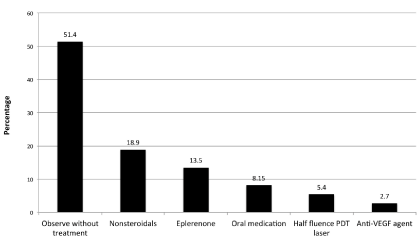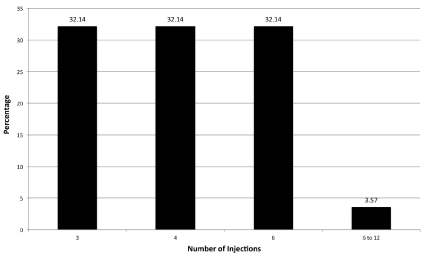Abstract
Purpose: Physicians frequently receive new information on the latest research from many different forms of media. It is interesting to see how they integrate this data and incorporate it into their own practices. This report focuses on physician opinions for the treatment of central serous chorioretinopathy and diabetic macular edema, as well as practice patterns associated with these treatments.
Methods: Retina specialists were surveyed during a lecture at the 2016 Ocular Imaging Conference in Vail, Colorado. Case studies were presented with questions integrated throughout the lecture that were designed to understand how physicians individually handle both specific cases and their specific treatment algorithms. When presented with multiple-choice questions, the audience texted their answers in to the Poll Everywhere application. Responses appeared on the screen in real time and were recorded for later use.
Results: The mean number of responses submitted per question was 30.15. Physicians answered 13 questions about management issues of central serous chorioretinopathy and diabetic macular edema, with some questions resulting in markedly varying answers.
Conclusion: The concept of using an text based polling app is a low cost, easy to use, efficient way to obtain greater audience input in case presentation conferences.
Keywords: Anti-VEGF; Central serous chorioretinopathy; Diabetic macular edema; Steroid
Abbreviations
CSCR: Central Serous Chorioretinopathy; DME: Diabetic Macular Edema; PDT: Photodynamic Therapy; SRF: Subretinal Fluid; APTC: Anti-Platelet Trialists’ Collaboration; MI: Myocardial Infarction; IOP: Intraocular Pressure
Introduction
The case conference format of medical education has been used for more than 100 years [1]. The advantage is that it is a relatively easy way to get ideas and second opinions from the audience regarding a specific diagnosis or the management of a complex disease process. The problem with larger case conferences is that due to their size, time constraints, and feeling of intimidation, the entire group rarely gets an opportunity to provide input on the management of any specific case being presented. As a result, the value of the entire collective wisdom of the audience is rarely obtained. Over the past 10 years, various audience participation systems have been integrated in lectures to try to overcome this situation. Conventional systems can be very expensive, requiring the use of external hardware or an increase in bandwidth (which venues charge a premium for) [2]. At the most recent OIC WAVE meeting, a new low cost system was introduced which had a relatively easy set up and resulted in a large percentage of the audience actively participating in the conference.
Methods
A Poll Everywhere account was purchased for $80 to use at the 2016 Ocular Imaging/WAVE Conference in Vail, CO [3]. This account works by using text messaging to allow individual audience members to anonymously answer questions using their mobile phones. The polling questions were created in advance and integrated in to the case presentations. Audience members joined the polling by texting in a code, and from there were able to text their responses to the survey questions. The presentation was connected to basic Wi-Fi and was able to respond almost immediately to questions and display the responses in real time.
Results
There were 40 participants in the meeting. We asked 4 questions on the management of specific Central Serous Chorioretinopathy (CSCR) cases, 6 on specific Diabetic Macular Edema (DME) cases, and 3 on practice patterns. The practice patterns questions were divided by disease type (CSCR and DME). The number of responses per question ranged from 23 to 37.
CSCR
When treating a CSCR patient with 20/30 vision, 51.4% would observe without treatment, 18.9% used nonsteroidals, 13.5% used Eplerenone, 8.15% would treat with oral medication, 5.4% preferred ½ fluence PDT laser, and 2.7% would treat with an anti-VEGF agent (Figure 1). When using an oral agent to treat CSCR, 46.88% preferred Spironolactone, 25% used Eplerenone, and 28.13% said they never use an oral agent. If treating a CSCR patient with 20/40 vision and increased SRF over the past 6 weeks, 53.9% used ½ fluence PDT laser, 30.8% gave Eplerenone, 7.7% administered an anti-VEGF agent, 3.9% used thermal laser, and 3.9% said they would observe without treatment. All (100%) retina specialists said they used reduced fluence PDT to treat CSCR. When questioned further, 73.9% said they prefer full dose and half fluence when using PDT laser for CSCR, and the other 26.9% apply half dose and full light duration.

Figure 1: Preferred treatments for a CSCR patient with 20/30 vision.
DME
Bevacizumab was the most common first line agent used for treatment of DME (71.4%), followed by Aflibercept (28.6%). Most retina specialists said insurance companies do not require them to have step therapy prior to using branded anti-VEGF drugs (55.9%). When asked how many injections they give before considering switching medications, an equal percentage answered 3, 4, and 6 injections (32.1% each), and the remaining 3.6% answered 6-12 injections (Figure 2). The majority of retina specialists gave 4 anti- VEGF injections before considering the use of a steroid (56.7%), 23.3% gave 3 injections, 6.7% gave 2 injections, and 13.3% said they hardly ever use a steroid (Figure 3). The most common steroid used was the Dexamethasone implant (67.9%), followed by Triamcinolone Acetonide (32.1%). When asked to summarize their opinions on the use of vitrectomy for the treatment of DME, 80% said it should only be used when an epiretinal membrane and/or vitreomacular traction are present, 10% think it has potential as an early option for most eyes, and another 10% said it should only be used when all other options fail.

Figure 2: Number of injections given before considering switching
medications.

Figure 3: Number of injections given before considering use of a steroid
when switching anti-VEGF agents.
Practice patterns
When asked how often they discuss the risk of Anti-Platelet Trialists’ Collaboration (APTC) events to patients undergoing an anti-VEGF injection, 58.1% said they discuss it only to patients with a pertinent history, 32.3% said they hardly ever discuss this risk, and 9.7% said they discuss it with every patient. In patients who have had a stroke or Myocardial Infarction (MI) within the last month and are undergoing anti-VEGF injections, 44.8% of retina specialists said they continue administering the same agent, 34.5% hold injections, and 20.7% change medications (Figure 4). When changing a patient to a steroid and discussing the risk factors of IOP increase, 58.6% talk about the possible need for medications, laser, or surgery, and 41.4% only talk about the possible need for medications.

Figure 4: Opinions on how to treat patients undergoing anti-VEGF injections
who have had a stroke or MI within the last month.
Discussion
Currently, there is no level 1 evidence demonstrating a proven therapy for the treatment of central serous chorioretinopathy. The basic consensus after this meeting for treating patients with CSCR was potentially using nonsteroidals first, followed by use of oral aldosterone blocking agents, and lastly performing PDT laser. Approximately 75% of retina specialists preferred using full dose and half fluence PDT laser, while the other quarter said they use half dose and full light duration PDT laser. In response to EARLY data [4], 66% of physicians will give 4 shots or less to treat DME before switching medications, and 90% of physicians will switch medications after less than 6 injections. Less than 4% will give more than 6 injections before switching medications. In addition, the EARLY data seems to be making a difference in decision-making because more than 85% of physicians consider using a steroid after administering 2 or more anti- VEGF injections for the treatment of DME. In terms of medication risk in patients with a recent history of MI or stroke, about half of doctors would not consider switching medications even though it is a risk factor for all anti-VEGF agents [5,6], while the other half is divided between holding injections or switching anti-VEGF agents.
Conclusion
Physicians develop practice styles based on a number of factors including initial training, new information generated by research studies, and individual clinical experiences. There is a spectrum in how different physicians approach a specific disease. By incorporating real time polling at physician meetings, it is possible to get an understanding of how this information is being translated into clinical practice. In some cases, it is very similar to clinical trial data that has been presented; in other cases, it may be markedly different.
References
- Hassan S. About Clinicopathological Conference and Its’ Practice in the School of Medical Sciences, USM. Malays J Med Sci. 2006; 13: 7-10.
- Hill R. Getting up to speed on event bandwidth. Convention Industry Council.
- Business and non-profit plans. Poll Everywhere [Internet].
- Allergan Presents EARLY Analysis Data at the American Academy of Ophthalmology (AAO) Annual Meeting. Dublin: Allergan. 2015.
- Lucentis US Prescribing Information. 2014.
- Eylea US Prescribing Information 2015.
